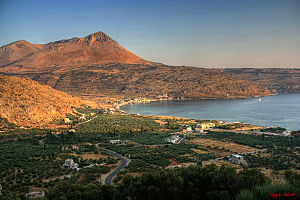| Mani - Greece (Photo credit: Wikipedia) |
Mani, the southernmost and middle peninsula of the Peloponnese or Morea, straddling the districts of Lakonia and Messenia in southern Greece, is a treasure trove of Byzantine and post Byzantine churches, Frankish castles and stunning scenery. The isolated aspect of this beautiful -yet mysterious- area, combined with the independent nature of its inhabitants meant that some traditions developed separately from the rest of the Peloponnese and Greece so that a distinct society made its mark on the landscape. To this day the architecture of the area is famed for the tower houses and fortified family dwellings from the period of the Ottoman occupation of Greece.
This region's coastal villages are adorned with cafes and souvenir shops and some popular beaches during the summer include Kalogria and the Stoupa harbor, while Kardamyli and Agios Nikolaos have nice pebble and sand beaches too. The ancient tower houses of Mani (pyrgospita) are significant tourist attractions, and some even offer accommodation for visitors.
But certainly the star attraction , aside from Mystras (which is close by) is the beautiful and mysterious Diros Caves. The Diros Caves are located approximately 12 miles south of Areopolis and they are part of an underground river. Archaeological research has shown that the caves have served as places of worship in Paleolithic and Neolithic times and their inhabitant believed that the caves were the entrance to the Underworld
The cave is essentially divided into three caves and stretches 14 km, the tourist route, however, has a total length of 1,500 meters. The temperature of the caves, continually ranges between 17-19° (at all times), and boat tours usually last for about half an hour.
About 5,000 meters have been exposed and are accessible by small boats and through narrow passageways.
Snow-white columns rising from the water, stalactites and stalagmites playing in tones of pink and elsewhere red, have given the names to the separate rooms: the Pillars of Hercules, the Lake Okeanidon, Palm Trees, the Chapel, the Stone Flower, the Pink Salons, Velvet Stalactites, the Lighthouse, Golden Rain, the Sea of Wreckage, the Chocolate Room, the Spider’s Net, the Cave of Bethlehem, the Flying Saucer, the Hall of Lovers, the Lake with Fairies are some of those encountered in the path.
Reproduction of the paleo-environment of western Mani after the Pleistocene period and its interaction with man, the realization of a systematic surface study of the environs of the Bay of Diros and the study and publication of the archaeological material unearthed were the three targets of the research programme "Diros excavation and research project" that was completed over the summer.
The Alepotrypa (Foxhole) Cave, the exploration of which began in 1970, was inhabited during the Neolithic Period (6000-3000B C) and has produced thousands of finds of clay, stone and bone tools, jewelry and human and animal bones. The 2012 studies began with a geoscopic study in the area of Xagounaki (Neolithic acropolis of Diros) at the northern entrance of the Alepotrypa Cave. This area gave up a heavy concentration of stone tools, shells and human bones from the Late Neolithic Period.
Excavations also turned up an undisturbed double child burial in an urn, sections of another burial from the Final Neolithic Period and three adult burials, also undisturbed. The concentration of the more than 160 burials found to date, combined with the large quantity of pottery and tool finds, lead to the conclusion that the area was heavily occupied during the Final Neolithic Period.
Noteworthy is the full absence of finds after the Neolithic Period, which indicates that the Cave and its surrounding area were not used after that period for systematic habitation.
Overlooking the Bay of Diros, Alepotrypa is a stalactitic cave that contains the remains of a Neolithic (Stone Age) village, burials, a lake and an amphitheater-sized final chamber that hosted burial rituals more than 5,000 years ago.
The Cave was sealed off from the outside world during a heavy earthquake at the end of the Late Neolithic Period, until it was accidentally discovered by locals in 1958. (Combined Reports, gogreece, AMNA, YouTube)








